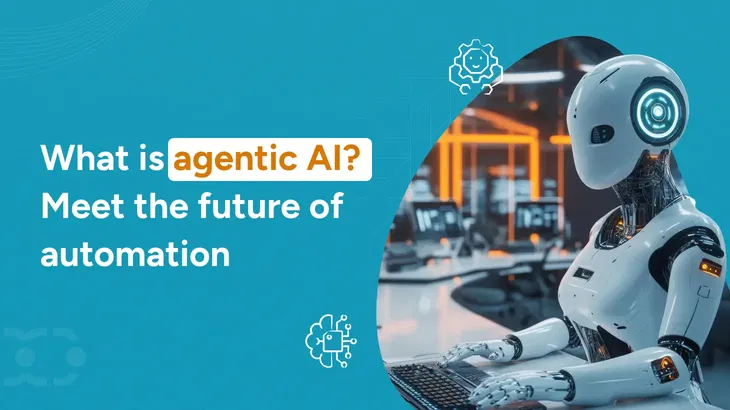We've all used AI that waits for a command, right? "Play music," "Schedule a meeting," "Find a pizza place."
Remember when Siri was the coolest thing around, answering questions with a touch of humor?
- But what if AI didn't wait for us to give them a task?
- What if AI had the power to think for itself?
That's Agentic AI. This autonomous artificial intelligence doesn't just follow orders; it acts, learns, and gets stuff done.
Let's see where this smart tech is taking us.
Keep reading.
What is agentic AI?
Agentic AI refers to artificial intelligence systems that can think, decide, and act independently to achieve specific goals without constant human input.
These systems often build on powerful AI models like GPT-4 or Claude, which serve as their cognitive engines, enabling them to reason, plan, and execute complex tasks.
The term agentic comes from "agency," meaning the ability to act autonomously and make decisions. So when we talk about agentic AI, we're referring to systems designed with:
- Autonomy – They operate without step-by-step instructions.
- Proactiveness – They anticipate needs and take action.
- Goal orientation – They pursue outcomes and adjust strategies based on results.
In simpler terms, it's AI with initiative.
Unlike traditional AI, which follows pre-set rules, and generative AI, which creates content based on prompts, agentic AI is designed to take action. It sets plans, coordinates AI agents, and completes goals autonomously. It's the difference between responding and resolving.
The below discussion will help you understand how agentic AI differs from traditional AI:
In short, traditional AI responds to commands. Agentic AI operates independently, driving decisions, coordinating AI agents, and delivering outcomes.
Before you get confused or end up messing/mixing agentic AI and AI agents, let's clarify:
- AI agents = Tools that perform specific, narrow tasks (e.g., scheduling, summarizing, flagging emails).
- Agentic AI = A system that orchestrates many such agents to accomplish bigger, goal-oriented outcomes, often with autonomy and memory.
Here is a simple way to understand agentic AI vs AI agents:
AI agent = a solo worker
Agentic AI = a full team with a manager and mission
Key benefits of agentic AI
It reduces manual effort by automating repetitive tasks like form-filling, meeting scheduling, and ticket triaging, but its value goes far beyond basic automation.
- Autonomy: It executes goals independently, and there's no need for constant input. For instance, it can autonomously reply to leads, schedule meetings, and update your CRM without human intervention.
- Continuous learning: It learns from every interaction, refining its responses. For example, a support agent spots repeat refund requests, flags issues, and adapts messaging automatically.
- Multi-step task execution: It breaks down big goals into smaller tasks, assigns them to the right agents, and completes entire workflows in one seamless flow.
With AI agents working across systems, Agentic AI drives productivity, speeds up processes, and delivers personalized results without needing more human resources.
Now, let's unpack how agentic AI works behind the scenes.
How does agentic AI work? [Architecture + Workflow]
Agentic AI systems are built like modular, intelligent teams.
Each layer performs a specific role but works together toward a shared goal. The system operates in a continuous feedback loop, from gathering inputs to making decisions and executing actions.
Let's break down the architecture and explore how AI agentic workflows operate behind the scenes.
Key components of agentic AI architecture
To function with autonomy and intelligence, agentic AI combines four key layers:
1. Large Language Models (LLMs): These are the reasoning engines. LLMs like GPT-4 and Claude interpret tasks, understand language, and generate decisions using natural language processing. They allow the AI to think, reason, and adjust based on context.
2. APIs and enterprise tools: APIs connect AI to real-world systems such as CRMs, calendars, internal databases, and support platforms. These integrations help the AI fetch live data and perform tasks like sending emails, updating records, or triggering workflows.
3. Orchestration layer: This layer manages everything behind the scenes. It plans task sequences, assigns agent responsibilities, monitors execution, and ensures progress aligns with the defined goal. Think of it as the system's project manager.
4. Multi-agent system: Rather than a single model doing everything, agentic AI orchestrates a team of specialized AI agents. Each handles a specific part of the process—research, decision-making, communication, or follow-up.
These layers enable the system to operate with logic, context, and autonomy.
Agentic AI workflow function in real-world scenarios
Agentic systems do not rely on static scripts.
Instead, they evolve through dynamic workflows where AI agents operate across tools, APIs, and databases, adapting to changing inputs and improving over time.







Key takeaways
We've all used AI that waits for a command, right? "Play music," "Schedule a meeting," "Find a pizza place."
Remember when Siri was the coolest thing around, answering questions with a touch of humor?
That's Agentic AI. This autonomous artificial intelligence doesn't just follow orders; it acts, learns, and gets stuff done.
Let's see where this smart tech is taking us.
Keep reading.
What is agentic AI?
Agentic AI refers to artificial intelligence systems that can think, decide, and act independently to achieve specific goals without constant human input.
These systems often build on powerful AI models like GPT-4 or Claude, which serve as their cognitive engines, enabling them to reason, plan, and execute complex tasks.
The term agentic comes from "agency," meaning the ability to act autonomously and make decisions. So when we talk about agentic AI, we're referring to systems designed with:
In simpler terms, it's AI with initiative.
Unlike traditional AI, which follows pre-set rules, and generative AI, which creates content based on prompts, agentic AI is designed to take action. It sets plans, coordinates AI agents, and completes goals autonomously. It's the difference between responding and resolving.
The below discussion will help you understand how agentic AI differs from traditional AI:
In short, traditional AI responds to commands. Agentic AI operates independently, driving decisions, coordinating AI agents, and delivering outcomes.
Before you get confused or end up messing/mixing agentic AI and AI agents, let's clarify:
Here is a simple way to understand agentic AI vs AI agents:
AI agent = a solo worker
Agentic AI = a full team with a manager and mission
Key benefits of agentic AI
It reduces manual effort by automating repetitive tasks like form-filling, meeting scheduling, and ticket triaging, but its value goes far beyond basic automation.
With AI agents working across systems, Agentic AI drives productivity, speeds up processes, and delivers personalized results without needing more human resources.
Now, let's unpack how agentic AI works behind the scenes.
How does agentic AI work? [Architecture + Workflow]
Agentic AI systems are built like modular, intelligent teams.
Each layer performs a specific role but works together toward a shared goal. The system operates in a continuous feedback loop, from gathering inputs to making decisions and executing actions.
Let's break down the architecture and explore how AI agentic workflows operate behind the scenes.
Key components of agentic AI architecture
To function with autonomy and intelligence, agentic AI combines four key layers:
1. Large Language Models (LLMs): These are the reasoning engines. LLMs like GPT-4 and Claude interpret tasks, understand language, and generate decisions using natural language processing. They allow the AI to think, reason, and adjust based on context.
2. APIs and enterprise tools: APIs connect AI to real-world systems such as CRMs, calendars, internal databases, and support platforms. These integrations help the AI fetch live data and perform tasks like sending emails, updating records, or triggering workflows.
3. Orchestration layer: This layer manages everything behind the scenes. It plans task sequences, assigns agent responsibilities, monitors execution, and ensures progress aligns with the defined goal. Think of it as the system's project manager.
4. Multi-agent system: Rather than a single model doing everything, agentic AI orchestrates a team of specialized AI agents. Each handles a specific part of the process—research, decision-making, communication, or follow-up.
These layers enable the system to operate with logic, context, and autonomy.
Agentic AI workflow function in real-world scenarios
Agentic systems do not rely on static scripts.
Instead, they evolve through dynamic workflows where AI agents operate across tools, APIs, and databases, adapting to changing inputs and improving over time.
The above image depicts the working mechanism of Agentic AI:
These agentic workflows in AI adapt and execute tasks with precision, learning from each cycle to improve future outcomes across changing business environments.
This flexibility and coordination make Agentic AI more than just automation. It's an intelligent, evolving system that drives real results.
Agent coordination models: Hierarchical and decentralized
Agentic systems are usually built in one of two architectural styles, depending on how structured or exploratory the task is.
There are two dominant coordination models:
In this model, a "supervisor" agent coordinates the work of other agents. It delegates tasks, tracks progress, and ensures alignment with the overall objective.
For example, in Salesmate, the system automatically assigns leads to the appropriate sales rep based on specific criteria like region, product interest, or rep availability.
The supervisor agent determines which sales rep should follow up on a lead. Other agents handle follow-up emails, meeting scheduling, and CRM updates, all under the supervision of the primary agent.
In this model, multiple agents work independently but collaborate to accomplish shared goals without one central authority.
Consider a product development team using multiple agents for market analysis, competitor research, and customer feedback analysis.
These agents work together, gathering data independently but sharing it in real-time to form a comprehensive product strategy.
Both models aim to accomplish tasks autonomously, but the structure changes how the work is approached, whether a single "leader" or collaborative peers.
Agentic AI vs generative AI
Generative AI, like ChatGPT and DALL-E, creates content based on prompts.
It can write blog posts, generate code, or create images. While incredibly creative, it cannot act autonomously or follow through on tasks.
Agentic AI goes beyond creating content; it plans, decides, and executes tasks autonomously. Think of it as a digital assistant that takes action independently, coordinating multiple agents to complete complex, goal-oriented functions without human input.
Here are the key differences: Agentic AI and Generative AI
Both types of AI have massive potential. However, understanding their core differences, strengths, and weaknesses will help businesses determine where and how to integrate them most effectively.
Agentic AI applications and use cases
From sales to cybersecurity, agentic AI models are redefining how businesses delegate, automate, and scale operations with minimal oversight.
Notably, 75% of enterprises leverage AI agents for tasks such as code generation, evaluation, and rewriting, underscoring the technology's growing role in software development.
Below are practical and real-world agentic AI examples:
Sales and customer service
Healthcare
Enterprise automation
Manufacturing
Finance
Cybersecurity
All these examples demonstrate how agentic AI systems operate with autonomy, adaptability, and goal-oriented behavior across diverse industries.
Orchestrate smarter workflows effortlessly!
Build and automate multi-step journeys with AI agents that think, act, and optimize in real-time.
Agentic AI frameworks and platforms
Behind every agentic AI system is a structured framework that integrates language models, orchestration layers, APIs, and tools, enabling AI agents to collaborate, reason, and act with autonomy.
Here are four AI agentic frameworks:
1. LangChain
A modular framework for chaining reasoning steps, memory, and tool use — ideal for building multi-step agentic workflows with LLMs.
Use case: Research agents that retrieve documents, analyze them, and summarize insights with citations.
2. AutoGen (Microsoft)
Built for multi-agent conversations. Agents like "planner," "coder," and "critic" work together to solve complex tasks.
Use case: Collaborative code generation and iterative problem-solving.
3. CrewAI
Specializes in structured teams of AI agents, each assigned a clear role (like researcher, strategist, or executor).
Use case: Automating marketing campaigns by delegating tasks like data gathering, messaging, and performance tracking to different agents.
4. OpenAgents (OpenAI)
It is designed to let GPT-based agents browse, reason, and act across web apps and tools using natural language in the early stages.
Use case: AI assistants that research, purchase, and schedule tasks in a unified flow.
What makes these frameworks truly "agentic"?
They're designed to drive outcomes autonomously:
Challenges and limitations of agentic AI
Agentic AI unlocks powerful autonomy, but it also introduces new risks. Here's what to watch for:
Future of agentic AI: What's next?
We're not heading toward a world where AI supports business decisions. We're heading toward one where it makes them.
According to Gartner, by 2028, 33% of enterprise software applications will embed agentic AI, enabling 15% of day-to-day decisions without human input.
That's not a distant vision — it's the near future knocking.
What does this mean?
This means that the shift from reactive AI assistants to proactive digital operators is underway. Smart agents will no longer be siloed helpers.
They'll collaborate across departments, syncing with CRMs, querying live systems, triggering workflows, and optimizing in real-time.
The future is agentic ecosystems:
Teams of autonomous agents work together — not just to assist but to operate entire functions.
Think of sales agents closing leads at night. Ops agents resolve bottlenecks before they escalate. R&D agents run tests while humans sleep.
The businesses that win won't just use AI — they'll orchestrate it.
Final thoughts
From strategy to execution, AI redefines what's possible when machines operate with intent.
Now's the time to move from exploration to implementation. Identify where intelligent agents can offload the repetitive, streamline decisions, and drive growth — all without bloating your headcount.
Don't just adopt AI. Put it to work.
Looking for what AI can do in sales? With Salesmate, you can orchestrate intelligent agents that automate follow-ups, update your CRM in real-time, and keep deals moving — even when your team is off the clock.
Frequently asked questions
1. What is agentic AI software?
Agentic AI software is a system that uses multiple AI-powered agents working in sync to achieve complex goals autonomously. Instead of responding to individual prompts like traditional AI, it plans, executes, and adapts — much like a smart team running on autopilot.
2. Can I use AI agents without building a full agentic AI system?
Absolutely. AI agents can operate independently for tasks like booking meetings or summarizing emails. However, Agentic AI enables them to collaborate under a unified goal, offering broader automation and impact.
3. What is agentic RAG, and how is it different from traditional RAG?
Traditional RAG (Retrieval-Augmented Generation) pulls external data to help an LLM answer questions better. Agentic RAG takes the next step: it retrieves, reasons, and acts on the information.
Here is an example of an eCommerce business using Agentic AI:
A customer asks to return a jacket.
It's the leap from answering to doing.
4. What industries are most likely to benefit from agentic AI?
Agentic AI is gaining traction in:
What are the ethical considerations surrounding agentic AI?
The more autonomous the system, the higher the stakes. Key concerns include:
Businesses must set clear boundaries, implement guardrails, and ensure transparency in making and executing decisions.
5. Can agentic AI systems be fully autonomous, or do they always require some human oversight?
While agentic AI can function with minimal input, complete autonomy isn't always ideal, especially in regulated industries. Human oversight is essential for setting goals, validating outcomes, and ensuring ethical alignment.
Sonali Negi
Content WriterSonali is a writer born out of her utmost passion for writing. She is working with a passionate team of content creators at Salesmate. She enjoys learning about new ideas in marketing and sales. She is an optimistic girl and endeavors to bring the best out of every situation. In her free time, she loves to introspect and observe people.